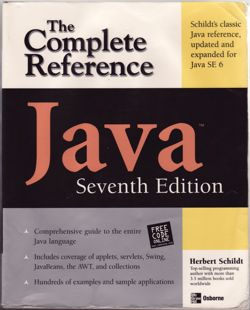 Author: Herbert Schildt
Author: Herbert Schildt
Started: 24 Feb 2008
Finished: 30 Nov 2008
1024 p / 281 d
4 p/d
So, this was one of these “I really should read this to improve my knowledge of things relevant to my job” books. I must say, I did an awful job of it. At least in terms of keeping up a decent speed going through the book. Rounded to the nearest whole number, I averaged 4 pages a day. (Really, it was more like 3.6 pages a day.) Sad. It is somewhat typical for when I read books of this type, but of course if I really prioritized it, I would spend more time. The pattern here was to read a few sections one day, then put the book down and not pick it up again for a month. And of course, the way I manage my reading, that blocked any other book reading in the meantime.
I wish I could use the excuse that it was slower because, I didn’t just read, but instead I went through all the examples, tried them on my own computer, made sure I understood exactly what each line of code was doing and why, and that I internalized the syntax and such. I did do that for the first chapter or two… basically the “Hello World” sort of stuff, but after that I rapidly transitioned into a mode of reading for the concepts and for getting a general sense of things rather than the mode I would have needed to be in to finish the book being able to actually sit down at a computer and do much with it.
Having said that, I did manage to get the general overview. It did give me a bit more depth than I had, although probably not as much as I would like. I still have on the agenda for 2009 to actually try to DO some simple Java stuff, going back and using this as a reference guide rather than an overview.
In terms of the book itself, I guess it was a fine overview, organized in such a way as to start with the simple stuff and build up, rather than just as a true “reference”. So it was good for starting from scratch and getting the basics. If there is one thing I would have liked, it would be examples that were more grounded in some sort of real activity… perhaps linking all the various examples to build a toy application of some sort, showing how all the bits could fit together. As it was, many of the examples were things like kicking off two threads and having them count independently, or having a method print its own name, or having a button that when clicked would print a message saying “Button was clicked” or whatnot. Those are fine I guess, but I tend to like examples that seem like they have a point of some sort. They are easier to engage with.
It was obviously not a big page turner though. I can’t say that each evening I’d find myself so drawn to see what was in the next chapter than I’d grab the book and read for hours. Just not that kind of book I guess. At least not for me. :-)
Leave a Reply
You must be logged in to post a comment.